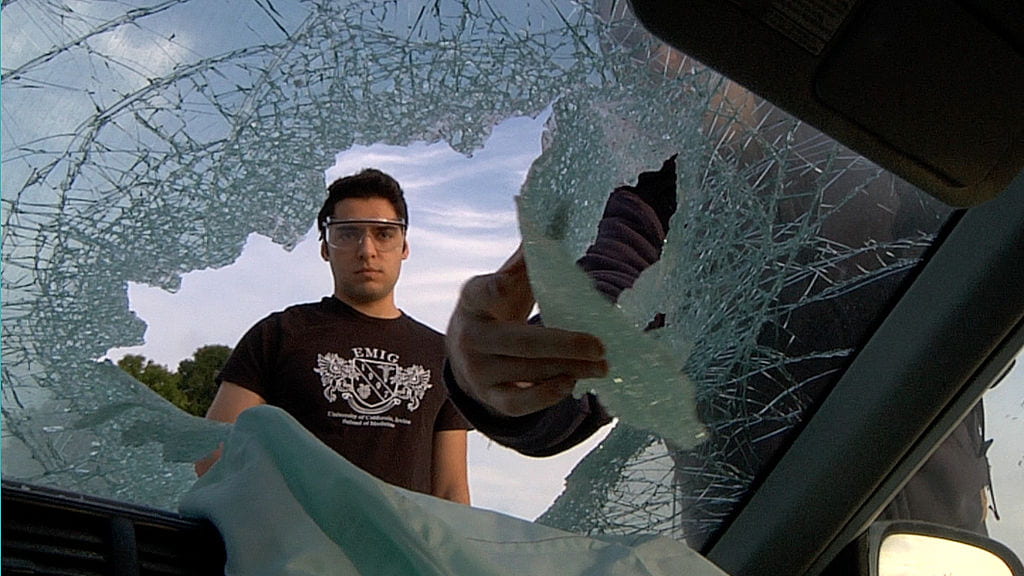Driving home DUI dangers
UC Irvine medical students interested in emergency medicine use a real-life recreation of a deadly car crash to drive home the dangers of drinking.

On a quiet morning in west Santa Ana, hammer-wielding UC Irvine medical student Ashkan Akasheh is pounding a body-sized hole through the windshield of a mangled Honda Civic. He isn’t breaking in, but prepping the vehicle for its part in a mock head-on collision with a crushed Toyota Cressida.
Plucked from a junkyard, the two cars – connected grill-to-grill on a dirt running track surrounding a football field – form the centerpiece of “More Than Just a Drink … ,” a drunk-driving prevention event organized by UCI’s Emergency Medicine Interest Group for the senior class at Valley High School.
Later that morning, as some 450 students fidgeted in the bleachers, a blare of sirens announced the arrival of Santa Ana motorcycle cops, paramedics and firefighters to a “prom night” accident scene. Six student actors, made up with bloody injuries, were sprawled inside and atop the cars.
Two played dead, including “Vanessa,” who was thrown through the Civic’s shattered windshield and across the hood, her formal dress torn and covered with blood. Three suffered severe injuries. As firefighters peeled back the Cressida’s roof to extract the victims, police tested and handcuffed the inebriated driver and escorted him away in a squad car, lights flashing.
The authentic recreation of a drunk-driving accident clearly affected the Valley High seniors, who would be attending their own prom two days later. They sat still and silent, focusing on the grizzly scene.
“We’re hoping to have an impact on them by showing something that’s real,” says Nick Sawyer, EMIG co-president. “Our overall purpose is to reach out and impress upon these students the dangers involved with drinking and driving.”
Sawyer is one of some 50 UCI medical students who comprise EMIG. While sharing an interest in emergency-medicine careers, they promote the field among their peers at other schools and conduct community outreach.
“Emergency medicine isn’t just shift work,” says Jamie Akiva Kahn, a fifth-year M.D.-M.B.A. student who will start an emergency medicine residency in Philadelphia this summer. “Community outreach is part of the job. You have to go out and work on prevention and education.”
EMIG is the largest and most active medical student group on campus, and for their achievements, they received a 2008 Living Our Values Award. The awards are given annually by Chancellor Michael Drake to staff, faculty and students whose actions best embody UCI’s values of respect, intellectual curiosity, integrity, commitment, empathy, appreciation and fun.
As part of their mission to teach and assist peers, EMIG students host a biennial Emergency Medicine Student Symposium, featuring lectures and workshops by faculty and medical-student instructors. On the off years, they stage the DUI prevention event at Valley High.
They model their program after those of the National Every 15 Minutes Foundation. After watching the fatal, drunk-driving accident scene, the students are ushered into the school auditorium to hear speeches on the tragic human toll of drunk driving and participate in small-group discussions led by EMIG students.
“Events like these are absolutely essential,” says Dr. Bharath Chakravarthy, an assistant clinical professor of emergency medicine at UCI who spoke that morning. “The more people you get a message out to in different venues, the more chance it can take root. You need to give a booster shot like this once in a while.”
Activities like these also help UCI medical students understand their responsibilities to the community once they become doctors, he adds.
“We learn that it’s important to show leadership,” says third-year medical student Shadi Lahham. “We want to get into medicine to help the community and have impact on a large number of people. Today, we will be helping hundreds of people at one time, and because of that, we hopefully won’t be seeing them in the emergency room one day.”